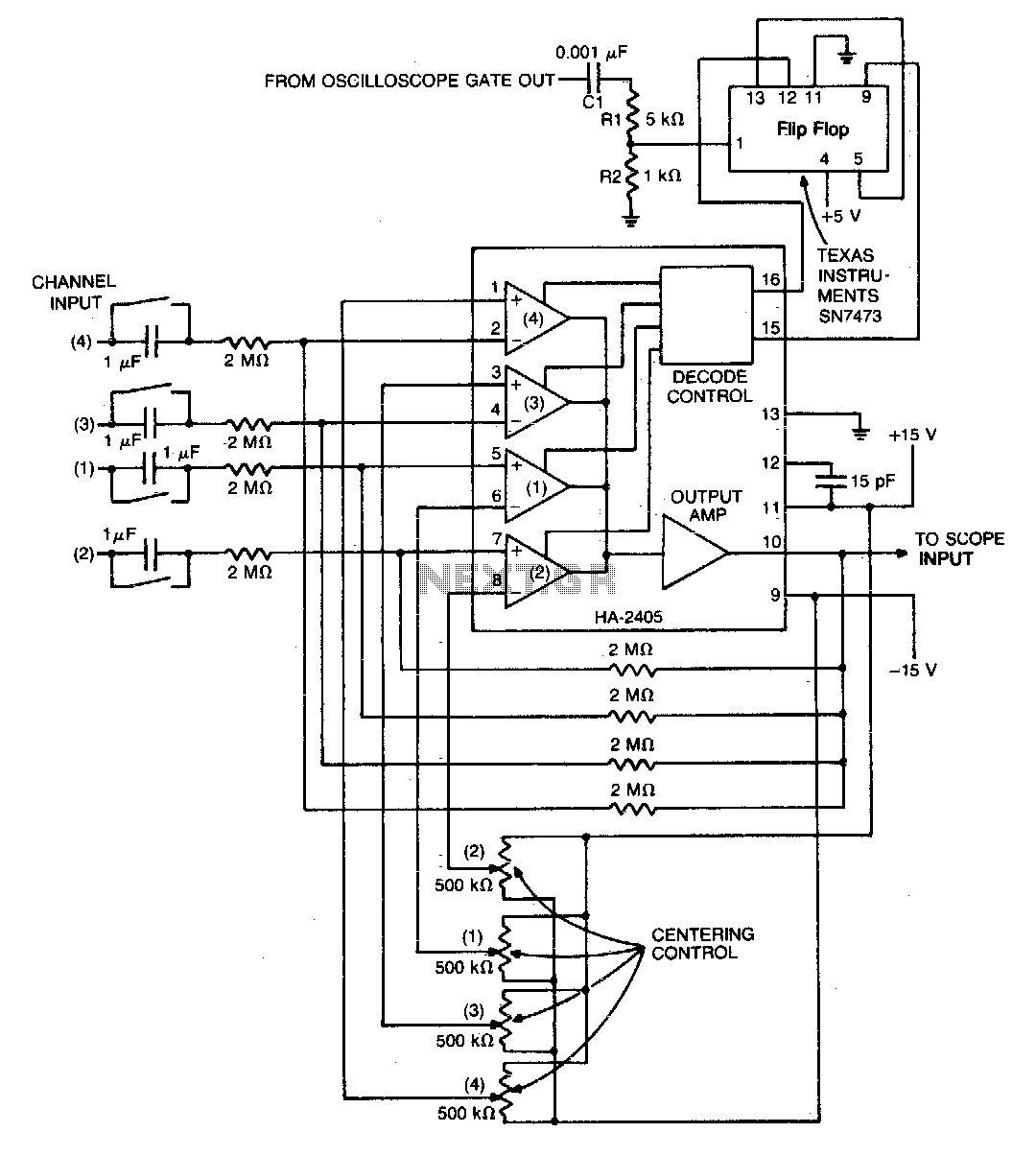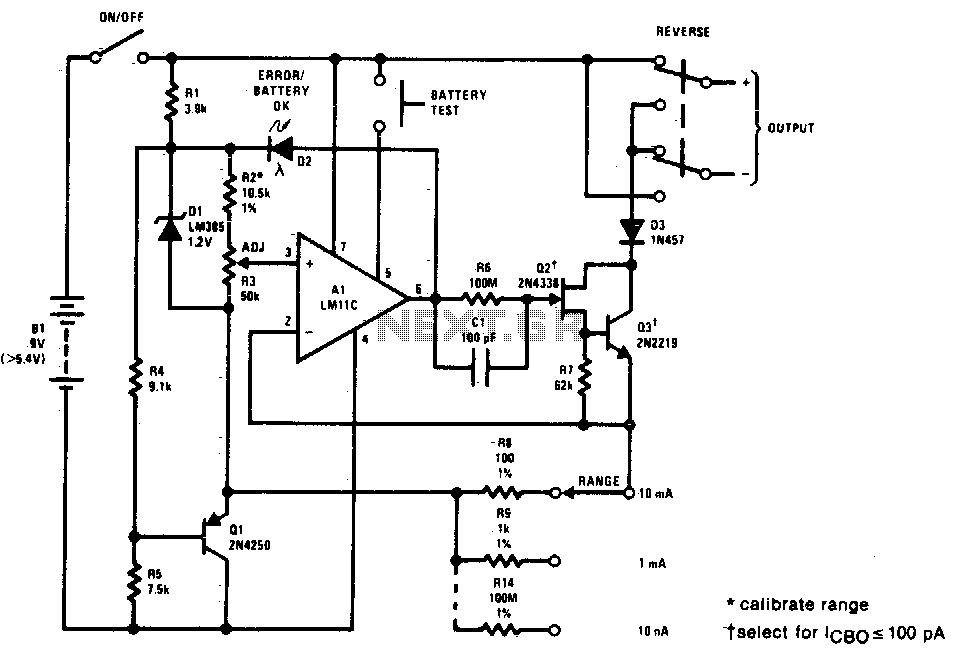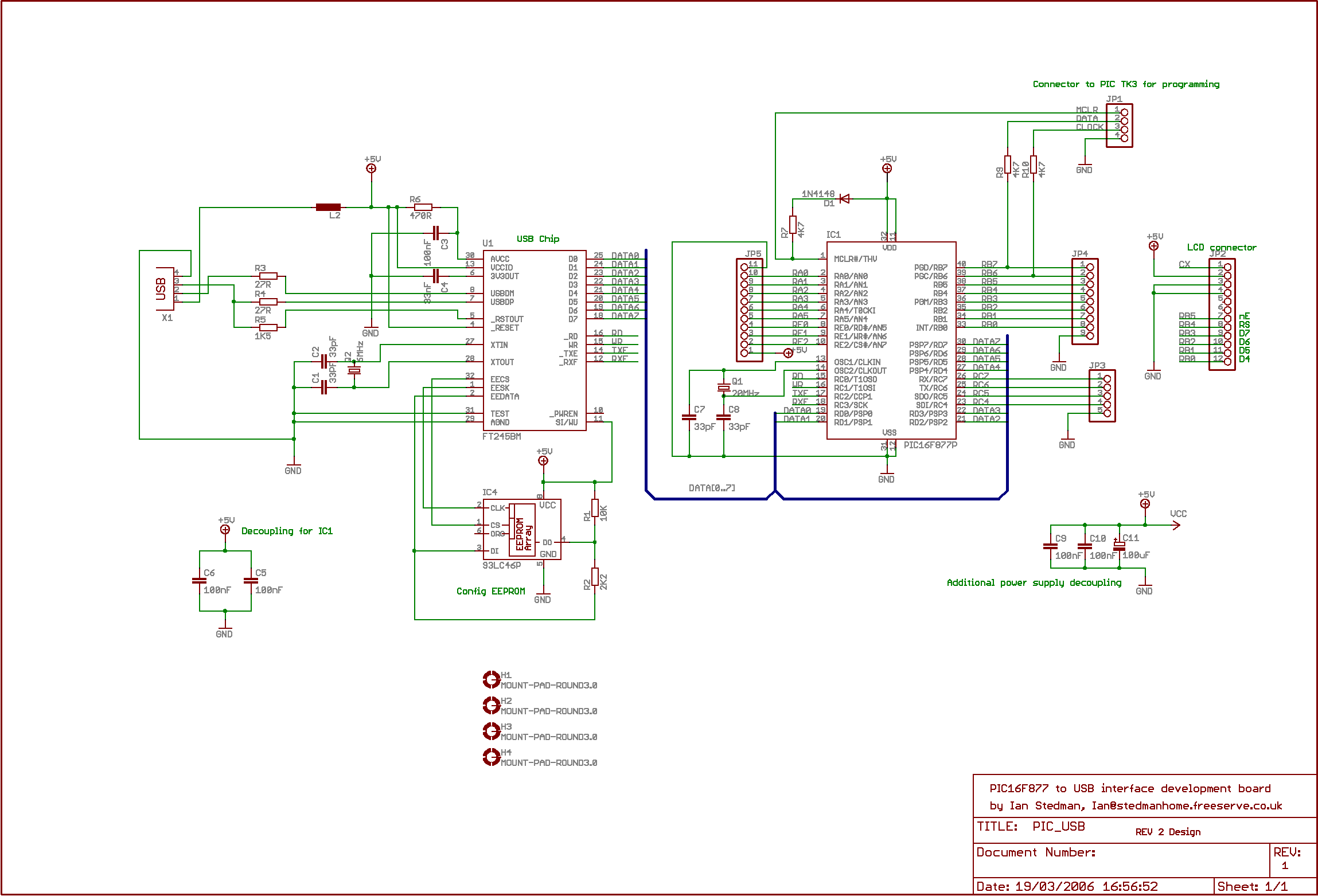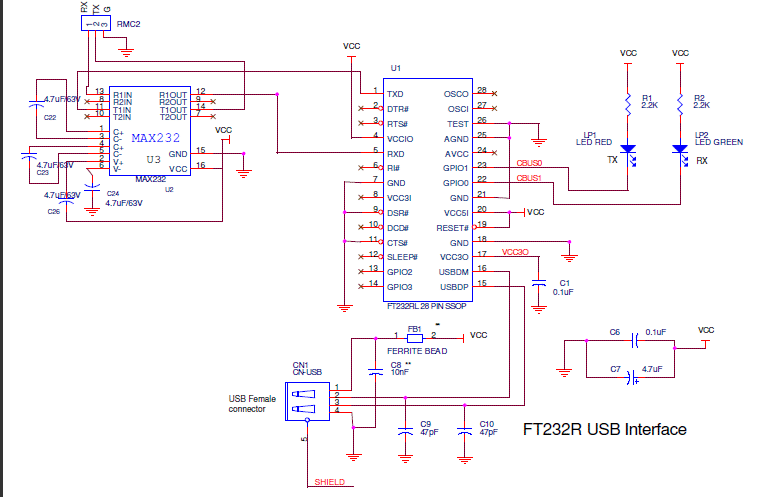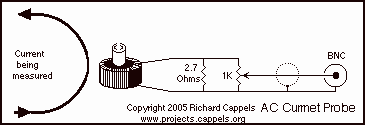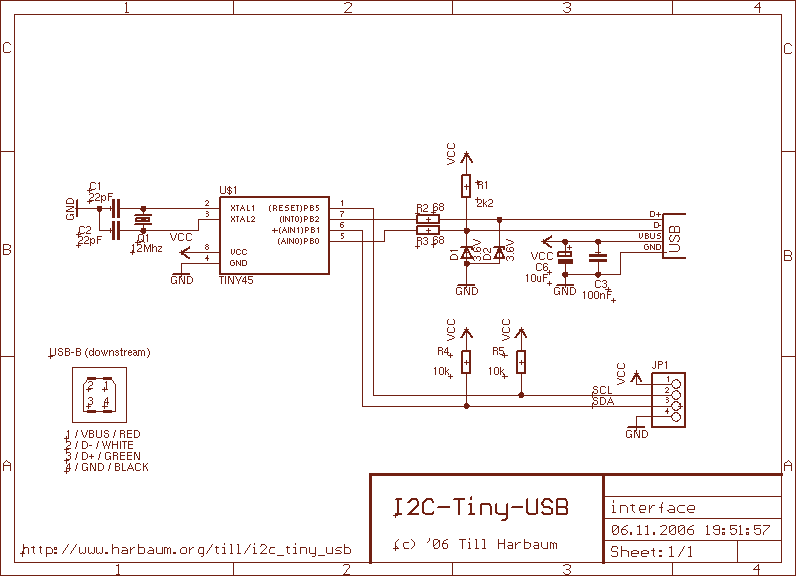
Open source USB scope

There are plans to achieve a sampling rate of 1 Gsps in the future using interleaved ADCs and staggered clocking; however, the initial iteration will only support 100 Msps, which is the maximum from a single ADC. The most uncertain aspect is the analog front end, as high-speed circuit design has not been covered in classes, and most knowledge is derived from various online sources. Input from BNC probes connects to a 1 MΩ resistor in parallel with 20 pF for compensation. The signal is buffered by a wideband, unity-gain stable JFET op-amp (OPA656) before being fed into a summer (the pre-amplifier of the programmable gain amplifier), which adds a bipolar offset from a DAC to the signal. It then proceeds to a programmable gain amplifier and finally to the ADCs. A significant issue with this front end is that the input overload protection is prone to failure, as any overvoltage input is directly shorted by the diodes, which is problematic. With modifications, it could potentially serve as a digitizer card for software-defined radio (SDR), particularly for GNU Radio. A sampling rate of 100 Msps is considered fast for a continuous capture digitizer card. The analog requirements are simpler, requiring a 50 Ω or 75 Ω input, with an input amplitude range of approximately 500 mVpp to 5 Vpp, and less stringent overload protection. In power electronics, it is ideal for transistors to be either fully on or fully off; a partially on transistor performs poorly. Currently, an internship as a software developer is being undertaken, making this project a weekend endeavor. The goal is to complete most of it before school resumes in eight months. Additionally, clarification is needed regarding continuous capture, which refers to the ADC constantly sampling at the desired rate and sending every sample to the host system, unlike an oscilloscope that transmits only parts of acquisitions. The limitation of USB 2.0 to about 40 Msps for a single channel necessitates considering a PCIe card for higher rates. If the smallest signal is 500 mVpp and AC coupled, several circuit components, such as the DAC for offset and the programmable gain amplifier, could be eliminated. The system could instead consist of an ADC with an FPGA managing the acquisition and an interface chip connecting to the computer. Continuous capture implies a constant sampling process, contrasting with the selective sampling of oscilloscopes.
The proposed electronic schematic outlines a high-speed data acquisition system designed for a sampling rate of 100 Msps, with future scalability to 1 Gsps utilizing interleaved ADCs. The system begins with BNC probe inputs that connect to a 1 MΩ resistor in parallel with a 20 pF capacitor, enabling input signal compensation. The buffered signal is processed through a high-speed JFET operational amplifier (OPA656), which provides a stable gain without introducing significant distortion or noise. The buffered output then enters a summer circuit, which integrates a bipolar offset generated by a digital-to-analog converter (DAC) to adjust the signal level appropriately before amplification.
The programmable gain amplifier (PGA) follows, allowing for dynamic adjustments to the signal amplitude based on the input range requirements, which are specified to be between 500 mVpp and 5 Vpp. This flexibility is critical for various applications, including software-defined radio (SDR) implementations. The output from the PGA is then sent to an analog-to-digital converter (ADC) for digitization.
A key design consideration is the input overload protection mechanism, which utilizes diodes to safeguard against overvoltage conditions. However, this design is prone to failure, necessitating careful consideration of input signal levels to prevent damage to the circuit.
Future modifications may simplify the design by eliminating the DAC and PGA if the system operates effectively with AC-coupled signals. The architecture could be optimized to include a direct ADC interfaced with an FPGA, which would manage data acquisition and communication with a host computer via a suitable interface, potentially a PCIe bus to accommodate higher data transfer rates.
This schematic design aims to provide a robust, high-speed digitizing solution suitable for continuous data capture, addressing the needs of modern applications while maintaining flexibility for future enhancements.There are plans to make it 1Gsps in the future, using interleaved ADCs and staggered clock, but that`s beyond me at the moment, so the first iteration will only have 100Msps (fastest from single ADC). The part I`m most unsure about is the analog front end, as we haven`t done any high speed circuit design in classes yet, so most of my knowledge com
es from random places on the internet. Would be great if anyone wants to take a look Input from BNC probes go into a 1Mohm resistor in parallel with 20pF (so the probes can compensate for it). The signal is buffered by a wideband, unity-gain stable JFET op amp (OPA656), before being fed to a summer (the pre-amp of the programmable gain amplifier), that adds a bipolar offset from a DAC to the signal.
Then it goes to a programmable gain amplifier, and finally the ADCs. The problem with that front end is that there is that the input overload protection will blow very easily. Any overvoltage input is directly shorted by the diodes - bad news! Perhaps, with modifications, it could be used as a digitizer card for SDR (software defined radio, GNUradio in particular) 100Msps is very fast for a continuous capture digitizer card.
The analog requirements are much simpler - 50 ohm or 75 ohm input, perhaps only a 500mVpp to 5Vpp or so input amplitude range, and much less need for overload protection. In power electronics, transistors should ideally be either fully on or fully off, because a half-on transistor just makes a really poor imitation of Tiffany Yep.
The problem with that front end is that there is that the input overload protection will blow very easily. Any overvoltage input is directly shorted by the diodes - bad news! I`m doing internship right now (as a software developer), so this is my evening and weekends project.
Hopefully I can finish (or at least finish most of) it before school starts again in 8 months. Perhaps, with modifications, it could be used as a digitizer card for SDR (software defined radio, GNUradio in particular) 100Msps is very fast for a continuous capture digitizer card. The analog requirements are much simpler - 50 ohm or 75 ohm input, perhaps only a 500mVpp to 5Vpp or so input amplitude range, and much less need for overload protection.
I`m not sure what you meant by continuous capture. Does that mean streaming samples That won`t work unless we make it a PCI[-E] card or something, since USB 2. 0 would limit the rate to about 40Msps, 1 channel. Also, if the smallest signal is 500mVpp, AC coupled (sounds like it to me), a lot of the circuitry can be taken out - the DAC for offset, and programmable gain amplifier.
I suppose it can just be an ADC with an FPGA coordinating the acquisition, and whatever interface chip to connect it to the computer. I`m not sure what you meant by continuous capture. Does that mean streaming samples That won`t work unless we make it a PCI[-E] card or something, since USB 2.
0 would limit the rate to about 40Msps, 1 channel. Also, if the smallest signal is 500mVpp, AC coupled (sounds like it to me), a lot of the circuitry can be taken out - the DAC for offset, and programmable gain amplifier. I suppose it can just be an ADC with an FPGA coordinating the acquisition, and whatever interface chip to connect it to the computer.
Continuous capture means the ADC is constantly sampling at the rate you desire and send every sample to the host system. Unlike an oscilloscope that only sends parts of acquisitions to the host system. My old Dell HDTV card (~9 years old, came in a used Dell GX110) has only an 8 bit ADC. It worked nicely back in the days, but can`t even come close to the modern cards that use 10 bits or more.
What`s interesting about it is that the decoder chip (Micron) appears to be a general purpose DSP or FPGA since there`s 8MB of DRAM and 512k of Flash on the board. (Too bad there`s no datasheet available, or I`ll reprogram it to operate as a digitizer card, complete
🔗 External reference
The proposed electronic schematic outlines a high-speed data acquisition system designed for a sampling rate of 100 Msps, with future scalability to 1 Gsps utilizing interleaved ADCs. The system begins with BNC probe inputs that connect to a 1 MΩ resistor in parallel with a 20 pF capacitor, enabling input signal compensation. The buffered signal is processed through a high-speed JFET operational amplifier (OPA656), which provides a stable gain without introducing significant distortion or noise. The buffered output then enters a summer circuit, which integrates a bipolar offset generated by a digital-to-analog converter (DAC) to adjust the signal level appropriately before amplification.
The programmable gain amplifier (PGA) follows, allowing for dynamic adjustments to the signal amplitude based on the input range requirements, which are specified to be between 500 mVpp and 5 Vpp. This flexibility is critical for various applications, including software-defined radio (SDR) implementations. The output from the PGA is then sent to an analog-to-digital converter (ADC) for digitization.
A key design consideration is the input overload protection mechanism, which utilizes diodes to safeguard against overvoltage conditions. However, this design is prone to failure, necessitating careful consideration of input signal levels to prevent damage to the circuit.
Future modifications may simplify the design by eliminating the DAC and PGA if the system operates effectively with AC-coupled signals. The architecture could be optimized to include a direct ADC interfaced with an FPGA, which would manage data acquisition and communication with a host computer via a suitable interface, potentially a PCIe bus to accommodate higher data transfer rates.
This schematic design aims to provide a robust, high-speed digitizing solution suitable for continuous data capture, addressing the needs of modern applications while maintaining flexibility for future enhancements.There are plans to make it 1Gsps in the future, using interleaved ADCs and staggered clock, but that`s beyond me at the moment, so the first iteration will only have 100Msps (fastest from single ADC). The part I`m most unsure about is the analog front end, as we haven`t done any high speed circuit design in classes yet, so most of my knowledge com
es from random places on the internet. Would be great if anyone wants to take a look Input from BNC probes go into a 1Mohm resistor in parallel with 20pF (so the probes can compensate for it). The signal is buffered by a wideband, unity-gain stable JFET op amp (OPA656), before being fed to a summer (the pre-amp of the programmable gain amplifier), that adds a bipolar offset from a DAC to the signal.
Then it goes to a programmable gain amplifier, and finally the ADCs. The problem with that front end is that there is that the input overload protection will blow very easily. Any overvoltage input is directly shorted by the diodes - bad news! Perhaps, with modifications, it could be used as a digitizer card for SDR (software defined radio, GNUradio in particular) 100Msps is very fast for a continuous capture digitizer card.
The analog requirements are much simpler - 50 ohm or 75 ohm input, perhaps only a 500mVpp to 5Vpp or so input amplitude range, and much less need for overload protection. In power electronics, transistors should ideally be either fully on or fully off, because a half-on transistor just makes a really poor imitation of Tiffany Yep.
The problem with that front end is that there is that the input overload protection will blow very easily. Any overvoltage input is directly shorted by the diodes - bad news! I`m doing internship right now (as a software developer), so this is my evening and weekends project.
Hopefully I can finish (or at least finish most of) it before school starts again in 8 months. Perhaps, with modifications, it could be used as a digitizer card for SDR (software defined radio, GNUradio in particular) 100Msps is very fast for a continuous capture digitizer card. The analog requirements are much simpler - 50 ohm or 75 ohm input, perhaps only a 500mVpp to 5Vpp or so input amplitude range, and much less need for overload protection.
I`m not sure what you meant by continuous capture. Does that mean streaming samples That won`t work unless we make it a PCI[-E] card or something, since USB 2. 0 would limit the rate to about 40Msps, 1 channel. Also, if the smallest signal is 500mVpp, AC coupled (sounds like it to me), a lot of the circuitry can be taken out - the DAC for offset, and programmable gain amplifier.
I suppose it can just be an ADC with an FPGA coordinating the acquisition, and whatever interface chip to connect it to the computer. I`m not sure what you meant by continuous capture. Does that mean streaming samples That won`t work unless we make it a PCI[-E] card or something, since USB 2.
0 would limit the rate to about 40Msps, 1 channel. Also, if the smallest signal is 500mVpp, AC coupled (sounds like it to me), a lot of the circuitry can be taken out - the DAC for offset, and programmable gain amplifier. I suppose it can just be an ADC with an FPGA coordinating the acquisition, and whatever interface chip to connect it to the computer.
Continuous capture means the ADC is constantly sampling at the rate you desire and send every sample to the host system. Unlike an oscilloscope that only sends parts of acquisitions to the host system. My old Dell HDTV card (~9 years old, came in a used Dell GX110) has only an 8 bit ADC. It worked nicely back in the days, but can`t even come close to the modern cards that use 10 bits or more.
What`s interesting about it is that the decoder chip (Micron) appears to be a general purpose DSP or FPGA since there`s 8MB of DRAM and 512k of Flash on the board. (Too bad there`s no datasheet available, or I`ll reprogram it to operate as a digitizer card, complete
🔗 External reference
